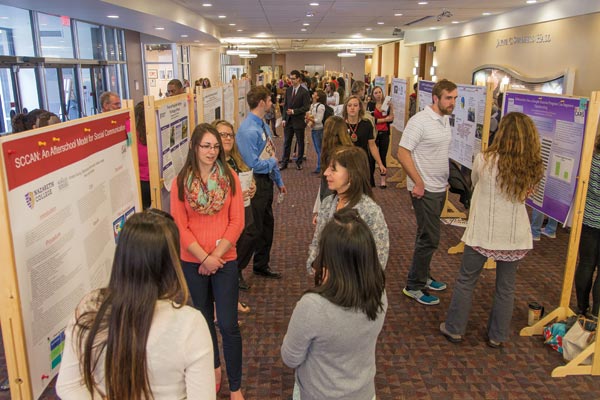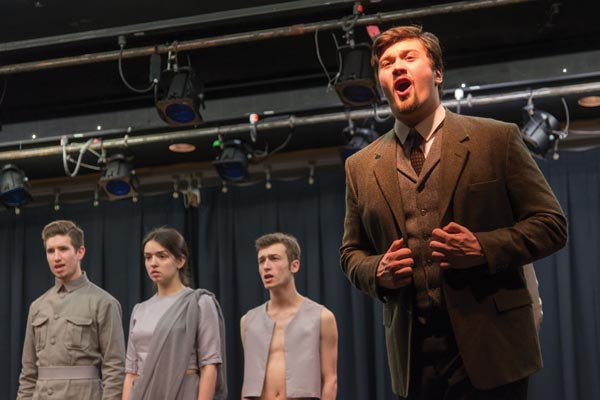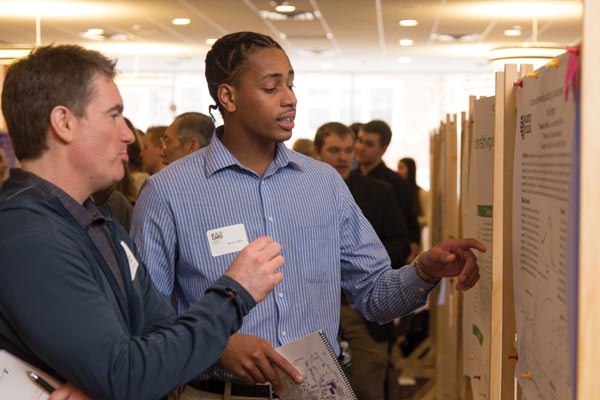Feature Story
Scholars’ Showcase
Students celebrate creative activity and research during an annual spring showcase
by Robin L. Flanigan
It started with store-bought cookie trays and a smattering of posters, presentations, panel discussions, and performances in Nazareth College’s Golisano Academic Center. The low-budget debut in 2012 of the now-named Creative Activity and Research Showcase (CARS), a college-wide symposium celebrating student work, was an experiment to foster and support the scholarly research and creative activity being done on campus.
“We weren’t sure if it was going to fly or flop,” recalls Debra Mathewson '88, grants coordinator in sponsored programs and faculty research and CARS coordinator. “It flew.”
Now in its fourth year, after finding a permanent home at the Nazareth College Arts Center, CARS gives students—through individual and group poster presentations, theatrical and musical performances—a unique opportunity to demonstrate career readiness and a mastery of experiential learning.
The showcase is open to the public; student posters are judged by faculty and staff volunteers during the event. In addition to having their work assessed, students must be prepared to discuss and defend that work, which tests oral, writing, and interviewing skills and requires them to present themselves in a professional manner. Performances are eligible for an audience choice award.
More than 260 students, guided for months by faculty sponsors, participated in early April. Of those, 165 students presented 75 posters, with topics ranging from how to keep bananas from ripening too quickly to the relationship between stem cell research and Catholic ethics.
“I work with students on very intense readings and discussions of theory and methods in the beginning of the course, then meet individually throughout the semester to articulate their research question, data collection and analysis, and help start the construction of their poster,” says Rachel Bailey Jones, Ph.D., assistant professor of education, who sponsored six students this year. “The bar and the stakes are raised with this event. This is work that needs to be polished much more than if they were presenting simply for their class.”
CARS is open to all majors. This year’s event drew a rise in participation from several departments, including communication sciences and disorders, education, women and gender studies, foreign languages, English literature, and performing arts. That increase underscores one of the reasons faculty members have been discussing ways to promote the breadth of research and creative activity that happens across the campus.
“We need to fully represent what Nazareth does, because not all research is about working in a lab with test tubes,” Mathewson explains. “We’re a liberal arts school and need to capture everything going on here, not just the hard sciences.”
In a recent report from the Association of American Colleges and Universities, called “Falling Short? College Learning and Career Success,” employers identified and ranked skills they most valued in applicants. The first was effective oral communication, followed by the ability to work effectively with others and the ability to communicate effectively in writing. CARS touches on each of those, says Mathewson, as well as the preferred skills that followed, including ethical judgment and decision-making, critical thinking and analytical reasoning, and the ability to apply knowledge to real-world settings.
This was the second year Claire Sobraske ’16 of Victor, N.Y., participated in CARS. The biochemistry major, with minors in biology and psychology, found her inaugural experience crucial to readying her for an American Chemical Society national meeting last year, where she took part in a poster session with more than 1,000 other undergraduate chemistry students. “It gave me a feel for what one of these poster sessions was like and prepared me for a larger meeting where I could network with professionals in my field,” says Sobraske, who this year investigated whether wastewater produced by hydraulic fracturing and full of harmful chemicals would be usable.
After working with Assistant Professor of Organic Chemistry Stephen Tajc, Ph.D., whose research has shown that a molecule known as dipicolinic acid, or DPA, can remove metals from this water, Sobraske is continuing research on another part of the project that involves growing bacteria in the presence of DPA. She wants to learn whether the bacteria, an unharmful probiotic found naturally in soil, can remove DPA and metals from the water as well. If so, she explains, millions of gallons of water produced every year by hydraulic fracturing can be reused rather than wasted.
It’s encouraging to see both faculty and students engaging in new and different ways to link what goes on in the classroom “to the ‘real world’ we’re always referencing,” says faculty sponsor Kim McGann, Ph.D., associate professor of sociology. “It’s true that internships prepare students for jobs, but research prepares students for jobs, too. I think the narrative about that could use some changing. This kind of organization, this kind of sharing, is what employers want.”
McGann, who has been on the CARS planning committee since its inception, requires her senior seminar students to participate in the symposium. (An increasing number of faculty members, in fact, are embedding a CARS project into their courses. Bailey Jones has done that for three years with her senior seminar students.) McGann’s sociology students, some of whom are double majors with education, work on “intricately nuanced” independent research projects that take an entire semester to produce.
“They have to distill all this very detailed, complicated, extensive knowledge and contradictions and findings into something that’s succinct and clear—and succinct and clear to someone who’s not necessarily in their field,” explains McGann. “That’s a really useful life skill, especially in terms of getting a job.”
Free of academic jargon, her students are expected to be able to answer a few simple questions: What did you do? How did you do it? What did you find? Why should anyone care?
For her CARS project, Anne Pysnik ’15, an environmental science and sustainability major from Sidney, N.Y., researched the ability of bean plants to remove Bisphenol A, a chemical commonly referred to as BPA, from water. The chemical, often used in making plastics, has been implicated as toxic because it can interfere with the normal metabolism of plants and animals. Given that BPA enters our environment through landfill leaching and industrial sewage, Pysnik sought out potential ways to remove BPA from the environment. She found that beans could be used to remediate aqueous ecosystems, though further research would be needed to evaluate its effectiveness with soil surfaces.
“Research forces you to not only formulate your own question, but also to figure out how to answer that question accurately,” she says. “To me, this is the point of experiential learning, to force students to ask and answer questions themselves.”
Some of those answers go far beyond a singular research project. Two years ago, Crista Johnson ’13 of Ilion, N.Y., was a double major in psychology and women and gender studies, unclear about what career she wanted to pursue after graduation. Through her CARS project, which focused on the feminist view of anorexia in college-age girls, she developed a strong interest in eating disorders. She now works as an administrator at an eating disorders treatment center in Manhattan and hopes to become more involved in advocacy and awareness.
“Reading all the information about eating disorders and hearing about issues with body image on campus made me want to make a difference in any way that I could,” she says during a recent workday.
Another benefit of CARS is that it requires students to break up big projects into small, digestible chunks.
“I think the way many courses are taught discourages that,” McGann notes. “CARS is more about ‘work steadily week by week and then revise’ as opposed to the ‘I wrote it the night before and wish I had another day’ model.”
There is also an opportunity to spread the word about the experiential learning that takes place both on and off campus. Lori Posato ’15, a communication sciences and disorders major with a minor in gerontology, participated in a group project that highlighted an Issues in Aging class, in which gerontology students entering the health care field learned side-by-side with older adults living at a long-term care facility.
“There is a lot of value in learning outside the classroom, and we hope others will appreciate that as much as we do,” says Posato, from Webster, N.Y. “Not only do the students and older adults learn from one another, but we enjoy one another’s company and friendships have formed.”
Bigger and better this year, CARS showcased cultural immersion experiences, spring break service-learning projects, field placements for student teachers, summer collaborations between faculty and students, and more.
Tyler Carr ’15, a visual communication design major from Saratoga Springs, N.Y., helped increase visibility and excitement for this year’s event—through her CARS project. Her submission detailed her work redesigning the CARS logo, designing poster templates, and promoting the event. The project allowed her “to push my creative limits as well as practice my critical-thinking and problem-solving skills,” she says.
Melissa Johnson, an instructor in communication sciences and disorders and one of about 30 judges, found the content of the 75 poster presentations—with titles such as “Legalizing High: An Analysis of Attitudes Towards Recreational and Medical Marijuana Use” and “Call Me Maybe? The Role of Technology in Romantic Relationships”—a testament to the amount of work that went into them. She said they rivaled the quality of those she sees at professional conferences. “And the students are well-spoken and knowledgeable,” she added after speaking with a few of them. “I’m thoroughly impressed.”
Such practice is a vital precursor for larger, national conferences like those sponsored by the nonprofit Chamber Music America or the Association of Performing Arts Presenters, according to Octavio Vazquez, D.M.A., assistant professor of music. The latter conferences, held each January, host 3,600 presenters, artists, managers, agents, and others from around the world for professional development, business deals, and performances.
“This gives them very good training for what these professional conferences really look like,” Vazquez notes. “They’re very competitive. You have to be ready to take off and go if you have an offer.”
Aside from the posters and presentations, this year’s event included theatre, dance, classical music, and alt-rock performances, followed by a panel discussion about creative processes and future career plans.
Shortly after the event started, Ruby Lananger ’15, a social work major with a minor in women and gender studies, watched for reactions to her project. To explore the power dynamic between restaurant customers and servers, norms in management culture, and hiring practices, she produced a side-by-side comparison of behind-the-scenes employment practices for Hooters and the Tilted Kilt Pub & Eatery—restaurants that put attractive female servers in skimpy costumes and have spawned the term “breastaurant.” Lananger sees the issue as encompassing both social justice and gender inequality, but she recognizes that not everyone sees it that way.
“I’m waiting for someone to challenge me on it, to say ‘What’s the big deal?’” she says. “I would love for that to happen.”
Though that challenge never came, Lananger did receive support from an observer who, frustrated by a local highway billboard promoting the Tilted Kilt that reminded her of Las Vegas, encouraged her to write an article about her exploration. Lananger hopes to continue exposing gender stereotypes as a social worker, perhaps in relation to the homeless community, after graduation.
CARS organizers are just beginning to look at metrics and benchmarks for participation, performance, and impact, says Mathewson. What they do know is that they want the event to continue growing, both in terms of student participation and community attendance.
“It’s a challenge every year to enrich the students’ experience and build audiences,” Mathewson says. “Our dream is to end up with so many applicants that space will be limited and this will become more competitive.”
Robin L. Flanigan is a freelance writer in Rochester, New York.


Shane Heidecker '15 (front) performs an ensemble from The Secret Garden, presented in April 2015.

Maurice Mills '16, a biochemistry major and basketball standout, discusses his poster "Synthetic Approach Toward Attaching a Pyridine-Based Cation Receptor to Solid Support."